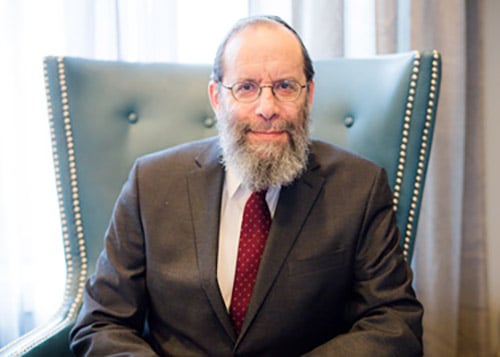All those who write about contemporary Halacha often cite “Teshuvot Tzitz Eliezer,” a collection of responsa authored by Rav Eliezer Waldenberg. Let us present a picture of Rav Waldenberg, his style of halachic decision-making and perspectives on his place in history. We celebrate a great man — who was somewhat underappreciated in his lifetime — and reflect on my interactions with him, in July of 1993.
Who Was Rav Eliezer Waldenberg?
Unlike the other leading rabbis of the twentieth century, such as Rav Yosef Dov Soloveitchik, Rav Moshe Feinstein and Rav Shlomo Zalman Auerbach, Rav Waldenberg did not serve as a rosh yeshiva (dean) or even a maggid shiur (teacher) in a leading yeshiva. He also did not function in any capacity in Orthodox organizations such as Agudath Yisrael, Mafdal (Religious Zionists)or Shas (Sephardic Orthodox).
Instead, he served in three capacities: He served for decades as a dayan (rabbinic judge) in the State of Israel Rabbinic Courts, most notably on the “Beit Din Hagadol” (Supreme Rabbinic Court). He lived and davened near Shaare Zedek hospital in Jerusalem and forged a connection with the physicians, who served in this hospital that strictly follows halacha. He delivered shiurim (lectures) in medical halacha to Shaare Zedek doctors, and addressed many thorny issues regarding 20th-century medical practice.
He is best-known, however, for his 24 volumes of responsa known as the “Tzitz Eliezer.” Medical halachic challenges comprise, approximately, a fourth of his teshuvot, and roughly another quarter address issues that arose in his service as a dayan in thebeit din. Most teshuvot are addressed to other rabbis who presented him with their questions. Another major work is his lengthy “Hilchot Medinah,” which provides guidelines for the State of Israel’s functioning according to halacha. Finally, his work “Shevitat Hayam” addresses the halachot regarding ship travel on Shabbat.
I had the privilege of accompanying Rav Efraim Greenblatt (a leading halachic authority, who resided most of his life in Memphis, Tennessee) on a visit to Rav Waldenberg’s home in July, 1993. I vividly recall Rav Waldenberg beaming with joy, while showing Rav Greenblatt the latest published volume of the Tzitz Eliezer. Rav Waldenberg — then 77 years of age — was elated at its publication, as if it were his first.
I thought his excitement would have cooled by that age, considering the many works he had already published. In retrospect, however, I understand Rav Waldenberg’s excitement because his published works represented the essence of his life’s work. It is fair to assert that his teshuvot were his yeshiva and his readers, his talmidim. His volumes — which will be studied in generations to come —, represent “the yeshiva” he built with all his heart and soul.
Rav Waldenberg’s Style of Halachic Decision Making
Rav Waldenberg may have been somewhat underappreciated in his lifetime since he was not a “party man,” as he did not affiliate with any particular segment of the Orthodox community. But, on the other hand, his “neutrality” endowed him with greater authenticity, as a ruling from Rav Waldenberg was not viewed as a “charedi ruling” or a “religious Zionist ruling.” Instead, his objective approach contributed to his rise to the top tier of 20 th-century halachic authorities.
On the one hand, Rav Waldenberg opposed bat mitzvah (18:33:1), opposed reciting Hallel on Yom Yerushalayim (10:10) and favored military exemptions for full-time Torah learners (Hilchot Medinah 3:3:4). On the other hand, he greatly respected Rav Kook (he signs a teshuvah (4:5:2), to Rav Zvi Yehudah Kook, “In friendship and admiration”), he enthusiastically supported medinat Yisrael — albeit not in messianic terms (7:48:12), he was ecstatic over the lightening Israeli victory of 1967, but does not frame it in messianic terms (10:1) and opposed introducing new chumrot (such as using a mirror to position tefillin properly; 12:6).
His neutrality was also reflected in some of his unpredictable, bold rulings. For example, he was probably best-known for his permission of abortions in certain extreme circumstances, such as if a fetus had Tay-Sachs disease (9:51:3). Other examples include his strong opposition to in-vitro fertilization (15:45) and cosmetic surgery (11:41 and 12:43). He was among the very first halachic authorities to rule that smoking is forbidden (15:39).
Rav Waldenberg was a leading champion of the halachic mimetic tradition in the second half of the 20th century. He would defend time-honored halachic practices of the pious Jerusalem community (Teshuvot Tzitz Eliezer 11:36 and 20:8, for example). This is hardly surprising, considering that he was raised and lived among devout Jews in Jerusalem. Moreover, he was fond of quoting the Aruch HaShulchan, a late 19th-century halachic authority who was a staunch traditionalist. I perceive Rav Waldenberg as a 20th-century Aruch HaShulchan.
Rav Waldenberg was remarkably erudite, and his teshuvot cited widely from an extraordinarily broad range of sources, including Sephardic authorities, which is not common among Ashkenazic poskim. He cites widely, but does not overwhelm the reader with erudition.
Tzitz Eliezer 12:8 is an excellent example of Rav Waldenburg’s deep respect for Sephardic practice. Rav Waldenburg and Rav Ovadia Yosef even regarded themselves as best friends. They often express their mutual affection in their respective teshuvot.
Perspectives on Rav Waldenberg’s Place in History
The twentieth century saw profound technological, social and political changes unprecedented in human history. Changes in technology radically changed humanity’s lifestyle. Most Jewish people were not observant of Jewish law (a situation that, baruch Hashem, continues to improve), and for the first time in nearly two thousand years, Jews had sovereign control over parts of Eretz Yisrael. Halachic authorities were challenged to apply the ancient halacha to an entirely new reality.
Rav Waldenberg was a key player in this miraculous process. With other luminaries of his rank, such as Rav Shlomo Zalman Auerbach, Rav Moshe Feinstein, Dayan Yitzchak Weisz and Rav Ovadia Yosef, a precedent was found in the Gemara and Rishonim for virtually every new phenomenon developed in modern times.
Two Samples of His Rulings
The following two rulings are representative of his approach and his personality. First, in Tzitz Eliezer 11:88, Rav Waldenberg was asked about a proposal to adopt the practice mentioned in the Shulchan Aruch (Even HaEzer 133:3) of requiring the presence of 10 individuals present when a husband presents his wife with a get. Rav Waldenberg begins by noting that the poskim in Jerusalem, Egypt, Hungary and Salonika (what a range of communities!) did not require the presence of 10at a get delivery.
He notes that the Gemara, Rambam, Rif and Rosh do not mention this practice. He then cites the Aruch HaShulchan (Even HaEzer. 154, Seder Get Temidi, number 18), which states that we may waive this practice when necessary. Therefore, Rav Waldenberg concludes that the procedure should not change: “In order not to severely discourage (non-observant) couples who are divorcing from procuring a get (as they will be disturbed) when they see a tumult surrounding them … as is understood by anyone involved in get administration.”
Rav Waldenberg demonstrates great sensitivity for the emotional needs and temperament of non-observant Jews who appear before Orthodox rabbis for a get. Therefore, he opposes introducing a chumra (stringency) that would disturb non-observant Jews. Indeed, when I served as a witness to a gittin that Rav Waldenberg administered for non-observant couples, Rav Waldenberg was friendly and engaged them in pleasantries.
In Tzitz Eliezer 10:1, Rav Waldenberg addresses the territories that Israel captured in the 1967 war. He waxes eloquent about this victory, and even considers the exciting possibility that kedushah rishonah (the holiness of the land established by Yehoshua conquering Eretz Yisrael) had now been revived after 25 hundred years. However, at the end of this responsum, he soberly observes:“As I understand, there is no, and there was never any intention to permanently retain the added areas (of the 1967 war). On the contrary, they (the Israeli government) are ready to relinquish control when there is the confidence we shall not be attacked. Therefore, this was not a conquest worthy of its name; accordingly, the added lands’ sanctity cannot be revived.”
Here, Rav Waldenberg displays his characteristic neutrality. A charedi posek would not compare the 1967 war to Yehoshua’s conquests, but many religious Zionists would not share his sober evaluation of the newly captured lands.
Conclusion
Thousands of people attended the funeral of Rav Waldenberg in Jerusalem, in November 2006. Unfortunately, this number pales compared to the 10s of thousands or even hundreds of thousands who participated in the funerals of leading Torah figures who have passed away in recent years and decades. This low number reflects an underappreciation of Rav Waldenberg. Rav Waldenberg was a great posek, but did not win a popularity contest.
However, the Gemara (Chullin 7b) teaches that “the righteous are greater in their death than during their lifetimes.” Rav Waldenberg’s seforim legacy earns him the place in Jewish history that he richly deserves.
Addendum to Last Week’s Column: As an important follow-up to last week’s piece on anti-Orthodox discrimination in the workplace, I was contacted by Allison Josephs, founder and executive director of Jew in the City. She wrote to me as follows: “The student should contact the hospital’s Diversity, Equity and Inclusion department and complain. We are operating in these departments in Hollywood now. It’s the place to voice such concerns.”
Rabbi Haim Jachter is the spiritual leader of Congregation Shaarei Orah, the Sephardic Congregation of Teaneck. He also serves as a rebbe at Torah Academy of Bergen County and a dayan on the Beth Din of Elizabeth.










